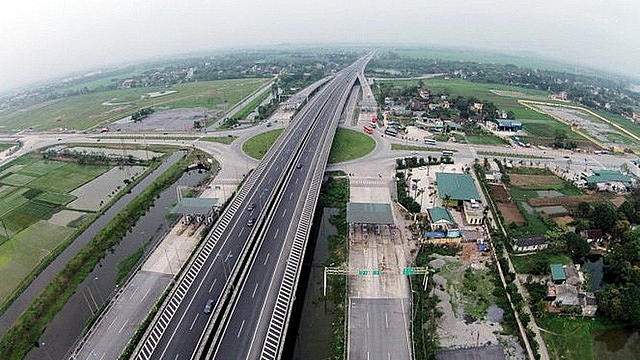Infrastructure development to be made foundation for the economy
 |
| Vietnam needs around $317 billion for infrastructural development by 2030 |
McKinsey Global Institute forecasts the need for over $2 trillion in investments in road, railway, port, airport, power, water, and telecommunications infrastructure across the ASEAN to maintain economic growth, including $770 billion for Indonesia, $317 billion for Vietnam, $310 billion for Thailand, $290 billion for the Philippines, and $277 billion for Malaysia.
By sectors, each power, roads, and telecommunication make up 24 per cent of the total infrastructure investment needed across the ASEAN, while another 28 per cent is captured by water, railways, airports, and ports.
To cater for this excessive demand, the Vietnamese government has collaborated with the World Economic Forum (WEF) to establish the Infrastructure Working Group in Vietnam (IWG), strengthening the attraction of infrastructure investment, contributing to Vietnam’s economic development in the era of innovation and Industry 4.0 is approaching and changing the structure of the economy.
| Private sector development is the motivation for economic development, going along with perfecting institutions, liberaliszing capital, labours, and lands market. |
Nguyen Van Vinh, vice chairman of the Development Strategy Institute (DSI) under the Ministry of Planning and Investment, said: “the quality of Infrastructure and synchronous development has not met the actual demand yet. The socioeconomic development strategy for 2011-2020 states that infrastructure development is one of the three major breakthroughs to be achieved to secure the economic development of Vietnam in the coming time. Therefore, the problems to solve are how to mobilise and manage resources in this sector, improve competitiveness, and welcome new challenges and opportunities.”
At the infrastructure development community workshop taking place on March 6, Eric Sidgwick, ADB country director for Vietnam, said: “In order to mobilise financial resources for infrastructure projects, Vietnam should complete the legal framework on PPP (public-private partnership) projects, including legal documents guiding implementation, as well as ensure synchronisation with relevant laws. We are ready to collaborate with Vietnamese agencies to share the experiences of other countries in formulating a legal system and promoting private sector participation.”
The decree on PPP should provide business input and recommendations to the new PPP law, as well as develop best practices to ensure there is one common “language” and clearly allocated responsibilities and solutions throughout the life cycle of the projects.
In addition to the PPP investment method, the chief of VinaCapital expressed that the asset recycling model through a pilot test case (PTC) to mobilise capital in the power sector while increasing Vietnam's electricity generation capacity is critical for the country's continued development.
Under the PTC, a consortium of investors would purchase a power plant from state-run Electricity of Vietnam (EVN), the proceeds from which would be used to construct a new power plant. Local banks supported by multilateral development banks and other investors would provide financing. The government would fast-track approvals for both the sale of the existing plant and construction of the new plant. The overall objective is to move on the concept, demonstrating the commitment of both the private and public sectors to address this issue in an innovative way.
Sharing some lessons learnt by other ASEAN countries, Evelina Fadil Pietruschka, chairman of WannaArtha Life, said that bank regulations are common problems to promoting long-term investment in the ASEAN.
The application of regulation requirements derived from bank-oriented regulations may negatively impact insurers’ role to provide long-term investment and stabilise the financial systems.
Bank-oriented regulations with focus on systemic risks and inter-connectedness may disincentivise insurers to stabilise the financial system and market, rather than mitigate systemic risks.
For short-term oriented economic regimes, economic valuation may be a significant barrier for long-term businesses, which may not be relevant to the insurers’ capacity to meet long-term obligations. Short-term oriented regimes tend to capture the risk assessment with a snapshot and consider long-term business and long-term investments as excessive risk taking.
“In order to constrain long-term investment, it is necessary for underdeveloped capital markets to collaborate with the developed counterparts,” noted Pietruschka.
What the stars mean:
★ Poor ★ ★ Promising ★★★ Good ★★★★ Very good ★★★★★ Exceptional
Related Contents
Latest News
More News
- Beyond borders: Sunhouse and new era of Vietnamese brands on Amazon (October 28, 2025 | 10:46)
- Record-breaking trade fair set to open in Hanoi (October 15, 2025 | 15:59)
- Timber sector seeks solutions to VAT refunds (October 14, 2025 | 18:58)
- Tether explores investment prospects in Vietnam’s digital asset sector (October 10, 2025 | 18:09)
- Vietnamese investors pour nearly $847 million into overseas markets in nine months (October 08, 2025 | 18:42)
- Vietnam amends Law on Civil Aviation to create drive airport investment (October 03, 2025 | 18:29)
- JICA, ECOM boost sustainable coffee farming (October 03, 2025 | 18:20)
- Agro-forestry-fishery exports surge 14 per cent (October 03, 2025 | 17:47)
- Marvell accelerates expansion in Vietnam with offices in Ho Chi Minh City and Danang (October 01, 2025 | 18:52)
- Hanoi leads top five in Provincial Innovation Index 2025 (October 01, 2025 | 18:45)

 Tag:
Tag:


























 Mobile Version
Mobile Version